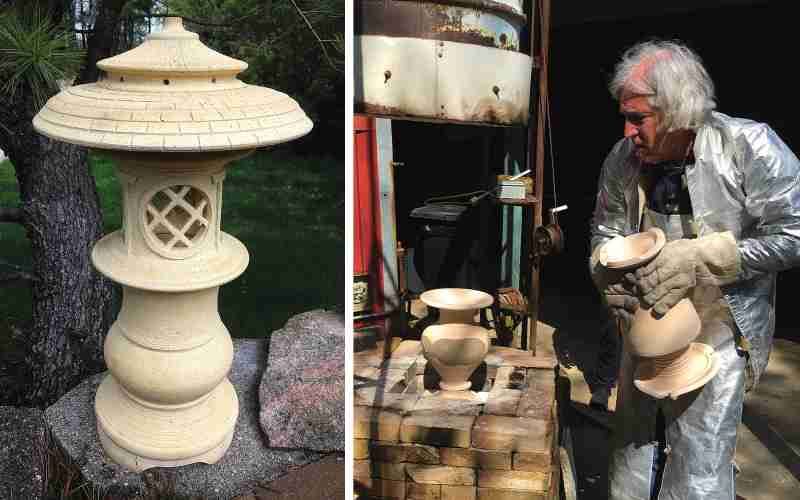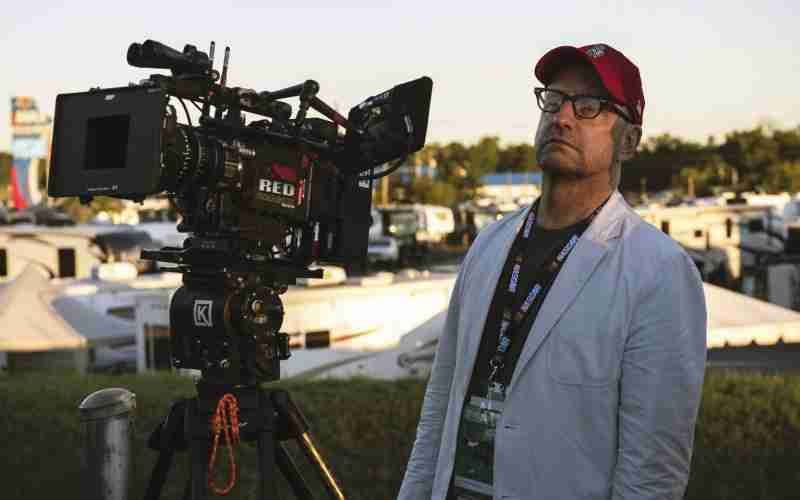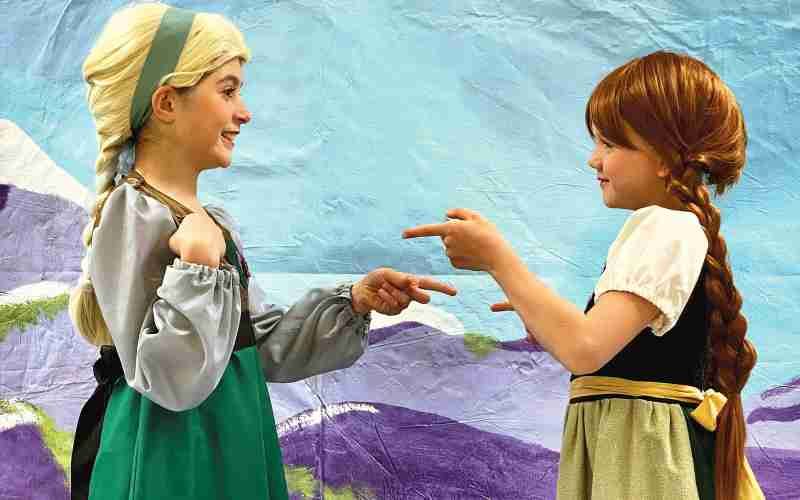When he knew he was dying of cancer, ceramicist Michael Minick said this to his wife Janie about the work he would leave behind: “You do whatever you want. Dump ’em in the pond. Smash them up.”
Mike passed away in 2018. What he left behind were more than 100 unfired ceramic vessels in and around his home in rural Hamilton.
None of them were small vessels. And Janie wasn’t sure at first what do with them or do about them.
“I really struggled in the beginning,” she said.
Janie’s journey with these vessels ultimately led to the first show devoted entirely to Mike’s work, “Revival By Fire,” which opens on May 13 at Castle Gallery.
The Story of Mike
The story of how Mike came to leave behind this unfired body of work is really the story of Mike.
Mike grew up in Fort Wayne and graduated from the Fort Wayne Art School. Janie grew up in Kansas and graduated from Kansas State College.
Angola potter Steve Smith, who would come to loom so large in the saga of Mike’s posthumous vessels, recalls encountering Mike at the art school.
“I was a freshman when he was a junior,” Steve said. “But I transferred to Bluffton University in Ohio the next year because I wanted to be a teacher. I knew Mike was a big-shot because he was Clyde’s assistant.”
“Clyde” is ceramics instructor Clyde Burt. He and sculptor Hector Garcia “were considered gods” at the school, Steve said.
As Clyde’s assistant, Mike must have seemed something like a demigod to fellow students.
In her junior year, Janie attended a pottery retreat in Grass Valley, Calif., called Earth Air Fire Water.
That’s where she met Mike.
“It was love at first sight,” Janie said.
The pair returned to their respective states to finish school.
The summer after Janie graduated in 1973, Mike drove to Kansas and brought her back to Fort Wayne with him.
Mike and Janie acquired some land in Steuben County and started to build a tool shed and a house on it while living in a teepee.
The rural electric co-op wouldn’t provide them with electricity at first, so they had to use hand tools.
“They just thought we were a couple of hippies out there,” Janie said. “Which we were. But once they inspected the quality of his building, they took him seriously. We were very qualified hippies.”
Mike was cagey about how long it would take him to build the house, Janie said. They ended up having to live in the tool shed, which was reimagined as a cabin.
“We were pretty naïve back then,” Janie said.
Large Art
It took Mike seven years to finish the house, but it was worth the wait.
“This is really his masterpiece,” Janie said.
From the basement floor to the sky, there is a chimney consisting of large stones from an art school party to which everybody was required “to bring a stone as big as their head or bigger,” Janie said.
Many years later, Mike could still remember who provided each stone, she said.
In the 1970s, Mike sold his finished vessels at the prestigious MindScape Gallery in Evanston, Ill.
“It was the top craft gallery in the country,” Steve said.
When Mike’s carpal tunnel symptoms made wheel throwing (aka shaping clay on a wheel) difficult, he switched briefly to making polyester resin wall sculptures. Large polyester resin wall sculptures.
“Of course, he didn’t do anything small,” Janie said, laughing.
Over time, Mike grew disillusioned with the art business.
“He was kind of eccentric in that,” Janie said. “He didn’t want to sell work. He just wanted to make it. He really became an introvert. The thought of dealing with people selling and packing stuff up, it wasn’t gonna happen.”
That’s a likely reason why the vessels were never fired, Janie said. Firing them would have made them more sellable, although unfired vessels (also known as greenware) have a beauty all their own, she said.
Mike was creative, patient, funny, an excellent chef, and in tune with the natural world, Janie said. He could also be stubborn, unreasonable, and stubbornly unreasonable.
Firing Up
After Mike died, Janie built a new garage on the property and displayed nine of Mike’s unfired vessels in upstairs windows.
Eventually, Janie decided she wanted to do more with the pieces — perhaps usher a few of them to a finished state.
“I had no intention of firing all of them,” she said.
She contacted Shirley Brauker, a well-known Native American potter living in southern Michigan, hoping Brauker could teach her pit firing and sawdust firing. Brauker knew Mike and recalled the size of his vessels. She sent Janie to Steve.
Steve has a pottery gallery in Angola near the convergence of Lake James and Jimmerson Lake known as “the four corners.” Steve, quite sensibly, named it the Four Corners Gallery.
Steve retired a decade ago from Defiance College, where he’d been a professor for 30 years.
Before Brauker sent Janie his way, Steve hadn’t had any contact with Mike since their art school days and he didn’t know Janie existed.
But he immediately became passionate about Mike’s ceramic works.
“Normally, the biggest pot I make is eight to ten pounds,” Steve said. “In my gallery, I’m selling mixing bowls and bread bakers and mugs. I didn’t make that many big pieces.
“This has got me excited,” he said. “This whole project has just kind of reinvigorated me about other things I want to do.”
The goal hasn’t just been to get the pieces fired. It’s been to fire the work in a manner Mike would approve of if he were still around to weigh in.
“When we sit down to glaze the work, we try to talk through it,” Steve said. “’What do you think Mike would do?’”
“We are trying to proceed with venerable intent,” Janie said. “Doing his work how we think he would have done it.
“My thought was, I don’t want to be imposing my design onto his pieces,” she said. “Our design. That’s why I wanted to do pit firing or barrel firing or (Japanese) Raku firing. Because you’re really at the mercy of the flame. The fire. The carbon.”
Steve has been forging metal stands for Mike’s pointed bottom pottery, aka amphora containers, and he believes that this might lead somewhere new for him.
“It would nice to be nationally known as an iron and stone furniture maker,” he said.
They started firing the vessels last October and didn’t even start discussing the possibility of showing the pieces until December.
Castle Gallery Steps Up
Janie contacted two venues that expressed interest in Mike’s work, but nothing could happen right away. Then she stopped in at Castle Gallery.
Mike and Janie have been friends with the owners of Castle Gallery, Jodi Hemphill Smith and Mark Smith, since the 1970s. It’s a friendship that once brought them all to Valparaiso.
In 1980, when Mark studying law at Valparaiso University and Jodi was head of the ceramics department at the school, Jodi hired Mike to build a kiln for the university.
“He had a one-man show and gave a slide presentation,” Janie said. “It was a big deal.”
Last March, Janie stopped by the gallery to see if Jodi might like to “take one or two select pieces.”
Recalls Janie: “She said, ‘No. You need to have the show here, Janie.’ I was totally blown away.”
Janie thinks Mike would be happy with everything that has happened and is happening with his work.
“I think Mike would be incredibly honored that it’s happening at the Castle Gallery,” she said. “He thought a lot of that place and the quality of work they showed there. Having the show there is spectacular.
“What Steve and I are doing… I think (Mike)would really be pleased,” she said. “He knew all along I wanted these finished pieces. They were so beautiful. He told me I could do whatever I wanted with them. I think he’d be pleased that we’re taking him into consideration.”
 Submit Your Event
Submit Your Event



